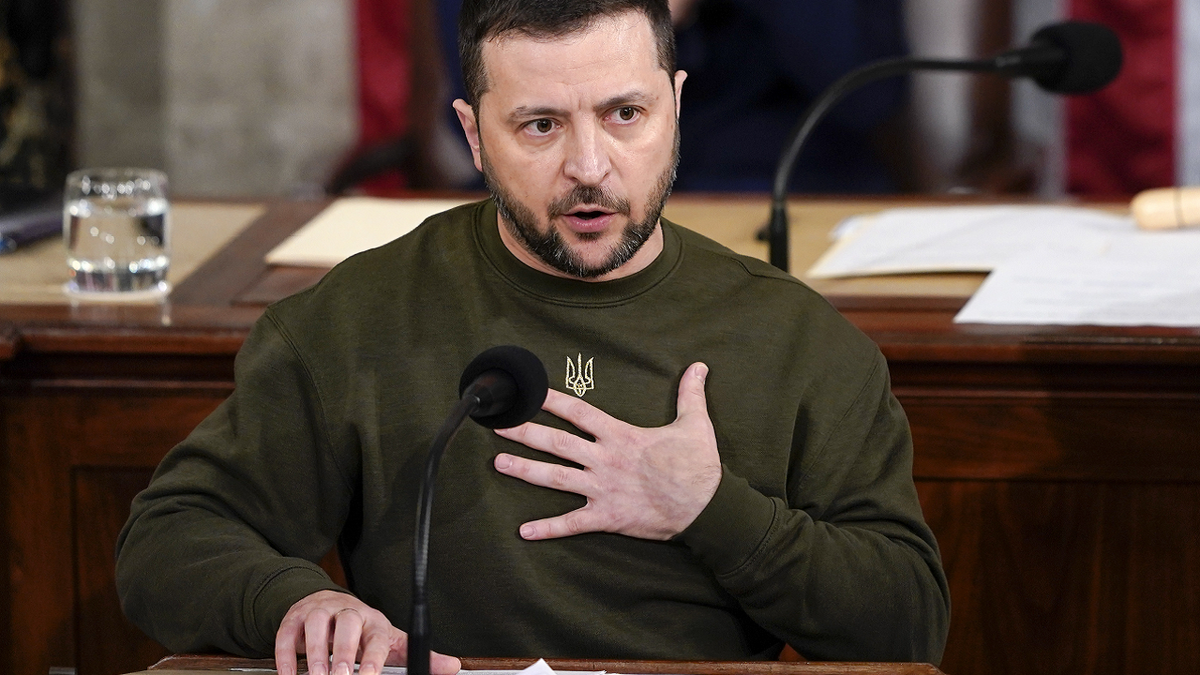Pentagon 'lost the big picture' in US aid to Ukraine: Rebekah Koffler
'Putin's Playbook' author Rebekah Koffler joined 'Fox & Friends First' to discuss the U.S. aid to Ukraine and the latest on Putin's assault.
As the largest war in Europe nears its first anniversary, it has become evident to all that President Biden and his security team have failed in their ongoing planning for Ukraine.
The prevailing thinking in the White House and the Pentagon revolves around giving to Ukraine the "right kit" – first, Stingers and Javelins, then HIMARs, Patriots, Bradleys, and now Abrams tanks.
Is this endless stream of high-tech military hardware supposed to make Vladimir Putin surrender? Here are three reasons why the Biden administration’s inability to craft a serious strategy, based on realistic goals and affordable costs, puts us all in danger.
1. A lack of strategy
President Biden evidently understands the risks of getting more and more involved in what is promising to be an unwinnable war. When criticized for his lackluster response to Putin’s assault on Ukraine last February, Biden explained why he would not deploy U.S. forces into Ukraine as follows, "That’s a world war when Americans and Russia start shooting at one another."
PUTIN'S PIVOT IN UKRAINE WILL BRING ABOUT PERMANENT WAR IN EUROPE
Biden also displayed a sound grasp of the danger of arming Ukrainians to the teeth when he evoked the possibility of Armageddon in an address to the Democratic Senatorial Campaign Committee in October.
And yet, what seemed to be off limits just a few weeks ago is now en route to Kyiv. A day after Ukrainian President Volodymyr Zelenskyy was promoting "big business" opportunities to U.S. and international investment firms – at the National Association of State Chambers meeting in Boca Raton, Florida – Biden announced the delivery of 31 Abrams tanks.
After Zelenskyy got his tanks, he is now asking for F-16 fighter jets, something the president has so far denied.

President Joe Biden and Russian leader Vladimir Putin (Alex Wong/Getty Images | Mikhail Svetlov/Getty Images)
What is driving Biden’s risky behavior? Is it another sign of his possible declining mental health? There’s certainly plenty of concern about that.
Last July, 54 House Republicans signed a letter to the president calling on Biden to take a cognitive test, a mental check that the president is yet to take.
Trying to protect her failing husband from mounting pressure, first lady Jill Biden has been hustling to "shield" her husband from journalists pestering him about the mishandling of classified documents.
Could it be Biden’s inability to stand up to foreign leaders?
The unexpected decision on the Abrams tanks came after German Chancellor Olaf Scholz refused to send Leopards to Ukraine until Washington supplies its own tanks. Is it another example of a gross lack of strategy from this administration?
Regardless of the driving factors, Biden appears to be on shaky ground, especially during this critical time when the conflict in Ukraine will likely escalate into a broader war in Europe and very possibly will drag the United States into it, too.
2. Failure to understand the adversary’s mindset and modern warfare
The Biden team naively rationalizes that Abrams tanks will change the battlefield dynamics as they are superior to the Russian main battle tank, T-90, an upgrade from the T-72. Indeed, the Abrams is an exquisite piece of armor laced with the very latest technology. But Putin is not a moron. Russia does not fight symmetrically.
There will be no repeat of the World War II Battle of Kursk, in which 3,000 German tanks clashed with Soviet armor, nearly double that number. After an eight-day "slogging match," the Russians won by what one military historian called "suicidal bravery" by getting close enough to throw mines under the tanks and having aircraft pick off German tanks from above. Consistent with Russia’s warfare style, Soviet forces out-sacrificed the Germans, with the Russians losing 3,800 tanks, while the Germans lost 760.

U.S. Army M1A1 Abrams tank fires during NATO enhanced Forward Presence battle group military exercise Crystal Arrow 2021 in Adazi, Latvia, on March 26, 2021. (Reuters/Ints Kalnins/File Photo)
What the Pentagon seems to forget is that the enemy does have a vote. Even the Taliban and insurgents have figured out a way around U.S. high-tech superiority, forcing the Biden administration to capitulate in Afghanistan. But not until U.S. losses in life and treasure brought reality to the tactically brilliant yet strategically incompetent Pentagon brass who pursued an unachievable mission for 20 years. The fact that U.S. tanks were vulnerable to the improvised explosive devices (IED)s was a big surprise to our "planners."
CLICK HERE TO GET THE OPINION NEWSLETTER
In response to a U.S. promise of tank deliveries to Ukraine, one of the Russian companies announced on Monday a cash bounty program aimed at incentivizing the Russian troops to be creative at neutralizing the threat of Western tanks. It offered $72,000 in cash to the first Russian soldiers who would destroy or capture American and Western-made tanks and $7,200 for attacks that follow. While Washington has upgraded its M1s to augment the tank’s survivability, the Russians who are watching its top perceived enemy’s every move no doubt have been working on counter-measures and counter-tactics.
Putin views the war in Ukraine as his Cuban missile crisis, as Ukraine’s potential acceptance into NATO would bring the alliance even closer to Russia’s borders. Moscow is putting everything on the line to minimize this risk that it views as unacceptable. The Pentagon is foolish to assume that the Abrams tank will become a game-changer in the war and will bring peace to Ukraine.
4. Reducing US combat readiness as China’s threat looms
The steady outflow of U.S. weapons that integrate top secret technology in them poses grave risk to U.S. security. The latest models of Abrams, for example, contain much classified data related to the upgrades aimed at survivability.
It is for this reason that every Abrams that is sold to foreign customers, even allies, has the depleted uranium armor – which is intended to mitigate vulnerabilities – removed, according to the specialized military website, Breaking Defense. What has become an unrestricted supply of top of the line materiel to Ukraine – which is not, officially, even a U.S. ally – drives up the risk of these secrets falling into our adversaries’ hands.

Ukrainian President Volodymyr Zelenskyy addresses a joint meeting of Congress on Capitol Hill on Dec. 21, 2022. (AP/Carolyn Kaster)
As Biden is hyper-focused on transferring the best of the best of our arsenal to help Ukraine, he is depleting our own weapons stockpiles, thus eroding our country’s combat readiness.
CLICK HERE TO GET THE FOX NEWS APP
According to a recent study by a Washington think tank, the replacement times for key weapons systems range from five to 18 years. We are in the red when it comes to 155 mm ammunition, Javelins and Stingers. The gap in the Stinger inventory will take 18 years to close.
The Wall Street Journal recently called out the U.S. armaments industry for its unpreparedness for a China conflict. Washington’s erratic actions during the highly-consequential Russia-Ukraine conflict, have exposed an absence of planning and strategy within the Biden administration. And that is reckless.


